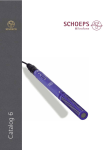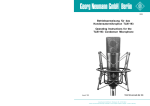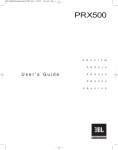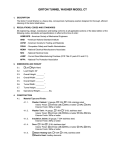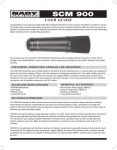Download Schoeps CMIT 5 U Specifications
Transcript
CMIT 5 U Interference Tube “Shotgun” Microphone Table of Contents Features / accessories Applications Filters Starting up Phantom powering Hints on avoiding interference Troubleshooting Care and maintenance Technical specifications Block diagram Warranty User Guide 14 page 15 17 18 19 20 21 22 24 25 26 27 English Features /Accessories Dear Customer: Congratulations on the purchase of your SCHOEPS CMIT 5 U shotgun microphone. To get the most out of your microphone, there are a few basic principles you should consider. This guide covers these principles, followed by some notes on wind and overload, as well as caring for your microphone. Technical data is provided in the appendix. Optional accessories: For Mono: WSR CMIT LU basket-type windscreen (100 mm diameter; comprises: elastic suspension, pistol grip, cable and Connbox WJ CMIT Windjammer for WSR CMIT LU Connbox Unique Features of the CMIT 5 U The CMIT 5 U is a classic condenser microphone (pressure gradient microphone) with an acoustic interference tube arranged in front of it. In the midrange and high-frequency range, this results in greater off-axis rejection than with supercardioids, the most strongly directional “short” microphones. The result is a lobe-shaped polar pattern. The CMIT 5 U stands out for: – its interference tube, which takes effect at a relatively low frequency without the pickup pattern becoming too narrow at high frequencies, – its excellent sound quality (making it a great all-purpose microphone, even for use as a spot microphone at music recordings, for example), – its very light weight, – its great immunity to wind noise, – a directional pattern which remains the same in both the vertical and horizontal plane, – three pushbutton-activated filters, – a balanced, low-impedance transformerless output, which allows interference-free operation even with very long cables – superior RF rejection WSR CMIT U WJ CMIT fur-like “overcoat” (“Windjammer”) for WSR CMIT U Available only at your Rycote dealer: Included accessories: W 140 SG 20 Rycote 12 cm “Softie” Polished wood case 15 Rycote “Softie Lyre Mount”; available as of June 2009 SCHOEPS GmbH · Spitalstr. 20 · D-76227 Karlsruhe (Durlach) · Tel: +49 721 943 20-0 · Fax: +49 721 943 2050 www.schoeps.de · [email protected] English Accessories For M/S stereo: WSR MS CMIT LU basket-type windscreen (100 mm diameter; comprises: elastic suspension, pistol grip, cable and Connbox), KMSC double clip (see page 18), WJ CMIT Windjammer (must be ordered separately) Further a microphone with a figure-8 directional pattern is needed – the CCM 8Lg. For Surround using the Double M/S recording technique: WSR DMS CMIT LU basket-type windscreen (150 mm diameter; comprises: elastic suspension with pistol grip and Connbox), 2 × KMSC double clip, WJ DMS CMIT Windjammer (must be ordered separately) Further the following microphones are required: 1× CCM 4Lg ”cardioid”, 1× CCM 8Lg ”figure-8”. WSR MS CMIT LU basket-type windscreen Connbox WSR DMS CMIT LU basket-type windscreen Connbox WSR MS CMIT U with WJ CMIT Windjammer WSR DMS CMIT LU with WJ DMS/ORTF Windjammer 16 SCHOEPS GmbH · Spitalstr. 20 · D-76227 Karlsruhe (Durlach) · Tel: +49 721 943 20-0 · Fax: +49 721 943 2050 www.schoeps.de · [email protected] English Applications Applications The CMIT 5 U is the ideal microphone for reporting, interviewing or dialogue for film and TV. It is one of the very few shotgun microphones in existence that can also be used as a spot microphone for music recording, thanks to its balanced frequency response and frequencyindependent polar pattern (with comparably little difference between low and high frequencies). Sound is picked up along its axis: Always make sure all of the slits in the tube (sound inlet openings) are free and uncovered when using the microphone. This is especially important when using M/S or double-M/S techniques requiring clips for mounting additional microphones onto the CMIT 5 U. Covering slits can alter the sound and directivity of the microphone. Here are some things which are worth knowing about ”shotgun” microphones, including the SCHOEPS CMIT 5 U: 1. For any given length of the interference tube, a shotgun microphone's design can be optimized for maximum directivity or for best sound quality, but unfortunately not for both at the same time. The SCHOEPS CMIT 5 U has been optimized for best sound quality. 2.1 Room reflections and reverberance contribute enormously to the character of any sound. With a shotgun microphone, the pickup angle at high frequencies will be narrower than at lower frequencies; as a result, diffuse room sound will be picked up with a distinct high-frequency rolloff, which can make the sound rather dull. This tendency will be emphasized further if a windscreen is used. The tendency toward dull sound can be counteracted with a high-frequency boost, which can also benefit speech intelligibility. The SCHOEPS 17 CMIT 5 U offers a built-in, switchable highfrequency boost of this kind. 2.2 The polar patterns of shotgun microphones often have multiple narrow lobes of sensitivity. These can cause disturbing combfilter-like effects when the microphone (or a sound source) is in motion, especially in indoor recordings. Special care was taken to smooth out these response lobes in the design of the SCHOEPS CMIT 5 U. 2.3 Since any off-axis sound will be picked up with reduced high-frequency content, a shotgun microphone must always ”track” (follow) a moving actor or other sound source precisely – particularly if the microphone is close to the person being followed and / or its interference tube is very long. Precise tracking is not always easy, and even if it can be done perfectly, other sound sources in the room (including noise sources and other nearby voices) will still be picked up from off-axis. 3. Since shotgun microphones are frequently used outdoors and / or on booms, they should have a low-cut filter available to suppress wind and handling noise. The SCHOEPS CMIT 5 U has a switchable low-cut filter of this type. In addition, any directional microphone will increase its pickup of low and lower-midrange frequencies when it is positioned near a sound source. To avoid false boominess, a shotgun microphone should also have a filter to compensate for this ”proximity effect.” These two requirements involve different frequency ranges and different ideal filter slopes, however, so a single low-cut filter is always a compromise at best. The SCHOEPS CMIT 5 U has a switchable low-cut filter with two different characteristics available: a relatively sharp cutoff for suppressing room rumble or wind and handling noise, or a more gradual slope that reaches somewhat higher in frequency to compensate for the proximity effect. 4. For high frequency sound, shotgun microphones increase the distance at which a good proportion of direct sound may be obtained. SCHOEPS GmbH · Spitalstr. 20 · D-76227 Karlsruhe (Durlach) · Tel: +49 721 943 20-0 · Fax: +49 721 943 2050 www.schoeps.de · [email protected] English Filters But using them still only makes most sense when they are already close enough for direct sound to predominate in the result. For outdoor recording this will not be an issue when there is little or no reflected sound energy – but indoors, even a shotgun microphone should generally be kept fairly close to the intended sound source. produce very good results. When mounting a figure-8 microphone or capsule on a shotgun microphone, one should be sure to place their diaphragms one directly above the other, remembering of course that the diaphragm of a shotgun microphone is at the base of the interference tube, not at its tip. 5. The usefulness of shotgun microphones for stereophonic recording is limited by the fact that their polar patterns differ at low vs. high frequencies. X/Y stereo recording with two shotgun microphones cannot really be recommended, but M/S stereo recording with a SCHOEPS CMIT 5 U with a small figure-8 condenser microphone or capsule (such as the SCHOEPS CCM 8 or MK 8) mounted on it can Filters The CMIT 5 U has three switchable filters. Each is activated or deactivated by pressing a button. They can be used to suppress low frequencies or to boost high frequencies. +5 dB at 10 kHz 300 Hz, 6 dB/oct. 80 Hz, 18 dB/oct. M/S arrangement with shotgun microphone (shown here: CMIT 5 U with CCM 8 and KMSC double clip.) The membranes of the two microphones must be aligned one above the other; the black line indicates their location. Make sure all of the slits in the tube (sound inlet openings) are free and uncovered when using the microphone. Covering slits can alter the sound and directivity of the microphone. * Reverberation radius (”critical distance”): A sound source generates a certain level of direct sound energy which diminishes strongly as a function of distance. If the sound is occurring in a room, some amount of diffuse sound energy will be built up by repeated reflections from acoustic barriers (mainly walls). The level of diffuse sound in any given part of the room will depend less on the distance from the sound source than is the case for the level of direct sound. In the theoretically ideal case, the level of diffuse sound would be the same everywhere in the room. The distance at which the reflected sound reaches an equal level to the direct sound is called the reverberation radius. (”Radius” is used because we assume that sound from a point source will spread out in a spherical manner.) 18 The two low-frequency filters start working from 80 Hz and 300 Hz. However, even when these are both switched off, there is another low filter active below 40 Hz at a slope of 6 dB/oct. The steep low-cut filter below 80 Hz (18 dB/oct.) suppresses wind and boom noise. The filter below 300 Hz (6 dB/oct.) is a gentle roll-off that compensates for proximity effects (elevation of low frequencies by directional microphones in near-field use). They also protect against disturbing, inaudible (infra-)sound that can be caused by ventilation systems, track vehicles and wind. What is tricky about this is that although it is hardly noticeable, infrasound can cause strong audible distortions in the connected equipment when it leads to an overload. This would make it impossible to produce a useable record. A high-frequency emphasis compensates SCHOEPS GmbH · Spitalstr. 20 · D-76227 Karlsruhe (Durlach) · Tel: +49 721 943 20-0 · Fax: +49 721 943 2050 www.schoeps.de · [email protected] English Start up /Phantom Powering for high-frequency loss caused by windscreens and enhances speech intelligibility. Pairs of LEDs next to each pushbutton indicate the status of the filters. Green means “Filter is OFF”, which means constant frequency response curve. Red means “Warning, filter is ON”. The settings are retained when the microphone is switched off. The LEDs next to each pushbutton let the operator know the filter settings and whether the microphone is on, even in the dark. Start-Up /Phantom Powering The CMIT 5 U is a condenser microphone. It is built as a combination of two main components: a capsule and a microphone amplifier. The capsule is the component that converts sound waves into a varying electrical voltage. It determines the directionality and, for the most part, the sound quality of the microphone. The amplifier of the CMIT 5 U possesses an electronic circuit needed to polarize (charge) the capacitive capsule. This hardly influences the signal, since it only amplifies it, making it low-impedance so that it can be sent through a cable. The output is electrically balanced, in order to eliminate electromagnetic interference in the cable. This prevents "AC hum“, for example. Filters cut out high frequencies picked up by the cable (e.g. from mobile phones). The microphone amplifier of the CMIT 5 U has a transformerless, class-AB output stage without condensers. This is what allows the low impedance, low distortion and small size. Start-Up The CMIT 5 U is an electrically active component which requires operating current. This will most often be supplied by the inputs of a mixer, preamplifier (such as the SCHOEPS VMS 5U) or recorder with suitable microphone powering built in. Like most modern, solid-state professional microphones, the CCM also uses a standardized powering scheme known as “phantom powering.” Most recording equipment offers a 48-Volt supply for such microphones. Our microphones are developed and tested with power supplies that conform to the requirements of this standard. Proper operation with non-standard power supplies cannot be guaranteed. Circuit arrangements that deviate from the standard can cause operational problems (i.e. distortion or even gaps in the signal), particularly at high sound pressure levels or in the presence of strong wind noise. Such problems may often seem to defy analysis until their real cause is discovered. &12''4 Shield + Phase !"#$%&' Fig. 1 Input with transformer (or balanced, ungrounded transformerless input) #38'2049 Powering )"*+, !N) /0123#$34' Microphone -("#$%&' Phase XLR-3 Connector :; ! <; !N) -"*., :; 5 1%67' Cable Input 04#=> ?+@A"<;B"+@"C"D"+"CE :;B"FG@"H!IG !/%JKB"5L"/M * Tolerance: ±20%, however, the difference between the resistors of any one pair should be less than 0.4% (i.e. 27 Ohms) 19 SCHOEPS GmbH · Spitalstr. 20 · D-76227 Karlsruhe (Durlach) · Tel: +49 721 943 20-0 · Fax: +49 721 943 2050 www.schoeps.de · [email protected] English Phantom Powering Phantom Powering to Standard DIN EN 61938 “Phantom” powering is the standard way to power condenser microphones. It works using a two-conductor, shielded cable. Both conductors are under the same voltage, and exactly the same current flows through both of them. Fig. 1 shows the only valid 48 V phantom powering circuit (abbreviation: P48) that can be built using resistors as opposed to a centertapped input transformer. This illustration is based on the international standard document EN 61938 from 1997. The permissible tolerance of the feed resistor values as such is ±20%. However, the difference between the resistors of any one pair should be less than 0.4% (i.e. 27 Ohms). This close matching is necessary to maintain adequate impedance balance for the sake of common mode rejection. It also avoids the flow of DC in an input transformer should one be present, which could lead to distortion or a reduced dynamic range. A microphone designed for 48 V phantom powering may draw as much as 10 mA according to the standard; a SCHOEPS CMIT 5 U will draw about 4 mA. This falls well within the limit set by the prevailing standard. Although there is nothing particularly complicated or demanding about phantom powering, there are certain commercially available power supplies, preamplifiers, and mixing desks – mostly older, but some more recent – which fail to meet this standard and hence may not be able to power SCHOEPS microphones adequately. If in doubt, equipment should be checked to verify its suitability for professional work with SCHOEPS microphones. A quick and easy way to check a phantom supply is described on page 26. Unbalanced Operation You may encounter a situation in which there is no balanced input with phantom power available, but only an unbalanced input – probably even unpowered. If the latter is the case, a standalone P48 supply with balanced in-/ouputs should be used before this input. 20 If the input has got phantom powering but is unbalanced, the temptation may be great, but we strongly advise against using it on the CMIT 5 U, since this microphone is not designed for such operation, and the advantages of phantom powering (noise and interference rejection) will be completely lost. Instead, a high-quality microphone input transformer should be used to turn an unbalanced into a balanced input. This will allow the signal leads from the microphone to be kept balanced, for best rejection of interference. If you have no choice but to go ahead despite the disadvantages of an unbalanced signal, then you can set up your system for unbalanced operation by uncoupling the signal on pin 2 using a capacitor (rating: 100 µF, 63 V at R= 22 kΩ). There is no signal on pin 3. Nevertheless, it must still be ensured that the microphone is fed over all three pins. With the CMIT 5 U, this operating method does not alter the signal-to-noise ratio. Simultaneous Connection to Multiple Inputs If a microphone has to be connected to multiple inputs simultaneously, an active microphone splitter should be used in order to preserve the loading and powering conditions for the microphone, and to prevent interference. Maximum Cable Length In the typical application of a shotgun microphone, namely on a boom, cables of just a few meters are used. The CMIT 5 U can be connected to cables up to 300 m in length. The practical limit depends on the electrical capacitance of the cable, which is sometimes an unknown quantity. The lower this capacitance is per unit length, the longer the cable can be. All SCHOEPS cables have very low capacitance (100 pF/m between the conductors). The main risks with excessively long microphone cables are gradual losses at high frequencies due to the cable capacitance, some reduction in ability to handle very high sound pressure levels, and increased pickup of interference. SCHOEPS GmbH · Spitalstr. 20 · D-76227 Karlsruhe (Durlach) · Tel: +49 721 943 20-0 · Fax: +49 721 943 2050 www.schoeps.de · [email protected] English Hints on Avoiding Interference Notes on Electromagnetic Compatibility SCHOEPS CMC microphone amplifiers are virtually immune to magnetic, electric and electromagnetic fields. Due to the wide dynamic range of studio microphones, the smallest signal amplitudes are in the microvolt range (1/1,000,000 Volt). Cable shielding and the grounding scheme of the preamp or mixer input are also crucial. A microphone can therefore never be expected to be immune to all possible disturbances in all circumstances, but the following suggestions can help to reduce any noise induction: 1) Keep both the microphone and the cable away from sources of interference such as monitors, digital equipment (computers), RF emitters (mobile phones and other personal communication devices that emit radio frequency energy), power transformers, power lines, SCR dimmers, switching power supplies etc. 2) Use only high-quality cables with a high degree of shield coverage, e.g. SCHOEPS K EMC 5 U. 3) Keep all cables as short as possible. 4) Dress audio cables away from power cables. If they must cross, it should be at right angles. 5) At the preamp or mixer input, the shield of the microphone cable should connect to the chassis ground in the shortest way possible. If necessary, this coupling can be capacitive. 21 SCHOEPS GmbH · Spitalstr. 20 · D-76227 Karlsruhe (Durlach) · Tel: +49 721 943 20-0 · Fax: +49 721 943 2050 www.schoeps.de · [email protected] English Troubleshooting Wind Noise and Windscreens Air motion (wind, vocal “popping” on sung or spoken consonants, motion of the microphone on a boom arm, or air currents due to heating or air conditioning systems) can cause noise that should always be dealt with. Even if it doesn't cause overload, it will detract from the clarity of sound. A wind or pop screen should be used, but should be chosen carefully to avoid changing the microphone's characteristics too much. Many screen types that are effective at reducing wind noise also have a tendency to reduce a microphone's directionality and/or its high-frequency response. Baskettype windscreens mainly cause some unevenness in the frequency response, while foam windscreens mainly tend to dampen high frequencies. Windscreens for the CMIT 5 U: Foam windscreen W 140 (included accessory) Fure-type windscreen “Softie”, 12 cm dia. Vibration If noise from mechanical vibration is going to reach a stand- or boom-mounted microphone, a shock mount (elastic suspension) should be used, and a loop of slack cable isolated and tied off so that it does not become another way for vibrations to reach the microphone. Unlike a windscreen, a shock mount will not affect the characteristics of a microphone. In many kinds of work it is well justified to use a shock mount ”by default”. Overload If transient or continual overload occurs, or seems likely to occur, it is useful to think of the complete set of equipment used for a recording or broadcast as a succession of ”stages”. The signal should then be attenuated (its level decreased) at the input to the first stage of equipment that might be overloaded. Reducing the gain at any earlier stage would add unnecessary noise, while reducing it at a later stage would not solve the problem. A condenser microphone itself represents at least two stages – the capsule and the amplifier. The only sound pressure that could overload a SCHOEPS microphone capsule (150+ dB SPL) would also damage human hearing almost instantly; in practice our capsules are rarely overloaded except by explosions or direct 22 Basket-type windscreen WSR CMIT U with Connbox included; below: WSR CMIT U with WJ CMIT Windjammer (must be ordered separately) Rycote “Softie Lyre Mount” (40 cm long XLR-3 cable included); available as of June 2009 SCHOEPS GmbH · Spitalstr. 20 · D-76227 Karlsruhe (Durlach) · Tel: +49 721 943 20-0 · Fax: +49 721 943 2050 www.schoeps.de · [email protected] English Troubleshooting exposure to very strong wind. As a rule such overload will not damage the microphone; even strong wind blowing directly against the capsule membrane will not harm it unless the forces involved are enormous. A properly powered SCHOEPS CMIT 5 U shotgun microphone can normally handle 130+ dB sound pressure levels. Such levels are hardly ever reached by natural sound sources. With a properly powered SCHOEPS microphone not exposed to wind, any overloads will occur far more often in a mixer or preamp's input circuit than in the microphone itself. This is particularly true with equipment that was designed primarily for use with dynamic or consumer-type microphones. Thus if distortion can be heard when the cause is obviously not wind, then one of the first tests might be to plug in a balanced ”pad” (resistive attenuator such as the SCHOEPS MDZ 10 or MDZ 20) at the console or preamp input to see whether that solves the problem. This type of pad is superior to built-in pad switches. Unfortunately, even with fully professional equipment, ”overload” indicators cannot always be relied upon to indicate input overload – many such indicators are wired only to later stages in the circuitry. If a preamp or mixer has an input sensitivity control, it should be set for a good compromise between avoiding input overload on the one hand (sensitivity too high) and avoiding noise on the other (sensitivity too low). Ideally a mixer or preamp should not add any noise of its own to a microphone's signals, but a dB or two of hiss is better than gross distortion caused by clipping. Low-frequency disturbances such as wind or vibration may not be perceived directly (subsonic noise), but can still cause overload in some stage of the signal chain. Low-frequency noise can be effectively suppressed using the Active in-line low-cut Filters LC 60 and LC 120. They can be placed between the output of the microphone cable and the phantom-powered input of a mixer, preamp or recorder, thus protecting that input from overload. 23 Any other overload for which there seems to be no sensible explanation may actually be a symptom of incorrect or inadequate microphone powering. Powering systems and their requirements are discussed near the beginning of this User Guide on page 19. The most appropriate and most helpful troubleshooting tools are: – a well-known good microphone cable – a simple pop screen such as the SCHOEPS W 140 (or for outdoor recording, a wind screen such as the SCHOEPS WSR CMIT U) – a balanced, in-line resistive attenuator (”pad”) such as the SCHOEPS MDZ 10 or MDZ 20 – an ordinary multimeter or the SCHOEPS PHS 48 phantom power tester LC 60 or LC 120 Active in-line lowcut Filter MDZ 10 resistive attanuator PHS 48 phantom power tester SCHOEPS GmbH · Spitalstr. 20 · D-76227 Karlsruhe (Durlach) · Tel: +49 721 943 20-0 · Fax: +49 721 943 2050 www.schoeps.de · [email protected] English Care and Maintenance Care and Maintenance Please take care to avoid placing the microphone in a dusty environment. Keep it in its case (e.g. the wood carrying case it comes with) when not in use, since any dust that gets inside the capsules can adversely affect its functioning. Dust can affect the microphone in the following way: In combination with humidity it can lead to condensation and thus popping and crackling noises (often described as “frying sounds”). What to do if … the microphone is noisy (clicks and pops) in high humidity? If the microphone is brought in from the cold outdoors to a warm (and humid) environment, snapping or clicking noises can result from the condensation of moisture. In this event the microphone should be given between 30 and 60 minutes to warm up, and will then generally perform flawlessly. If this treatment does not eliminate the noise, it is possible that dirt has gotten inside the transducer (capsule) itself – in which case the microphone must be sent back to the factory for cleaning. We strongly advise customers not to open a microphone or attempt to clean it themselves. Doing so would also invalidate all warranties. Windscreens are recommended when microphones have to be used in dirty or dusty environments in order to avoid problems of the kind described above. 24 SCHOEPS GmbH · Spitalstr. 20 · D-76227 Karlsruhe (Durlach) · Tel: +49 721 943 20-0 · Fax: +49 721 943 2050 www.schoeps.de · [email protected] English Technical Specifications Technical Specifications: Directional pattern: . . . . . . . . . . . .Supercardioid / lobe-shaped Frequency range: . . . . . . . . . . . . .40 Hz – 20 kHz Switchable filters: . . . . . . . . . . . . .80 Hz with 18 dB/oct., 300 Hz with 6 dB/oct., 5 dB lift at 10 kHz (shelving) Sensitivity: . . . . . . . . . . . . . . . . . .17 mV/Pa Equivalent noise level (filters off): . .14 dB-A*, 24 dB CCIR** Maximum sound pressure level: . .132 dB SPL at 0.5% THD Polarity: . . . . . . . . . . . . . . . . . . . .An excursion of the diaphragm towards the back electrode (positive pressure phase) leads to a positive signal at pin 2. Powering: . . . . . . . . . . . . . . . . . .48 V ± 4 V phantom Current consumption: . . . . . . . . .4.4 mA Maximum output voltage: . . . . . .1.3 V (at 1 kHz, 1 kOhms) Output impedance: . . . . . . . . . . .50 Ohms Recommended load impedance: . .600 Ohms or greater Dimensions: . . . . . . . . . . . . . . . . .Length: 251 mm, Diameter: 21 mm Weight: . . . . . . . . . . . . . . . . . . . .Only 89 g (3-1/8 ounces) Surface finish: . . . . . . . . . . . . . . . .Anodized * According to IEC 61672-1 ** According to IEC 60268-1 +10 0dB -10 -20 20 50 100 200 500 1k 2k 5k 10k 20kHz Frequency response (tolerances shown) +10 5 0dB From outer to inner: 250 Hz 500 Hz 1 kHz 2 kHz Polar diagram -10 4 kHz 8 kHz 16 kHz -20 20 1 1 2 3 4 50 100 200 500 1k 2k 5k 10k 20kHz Frequency response curve: 1) Without filters 2) 80 Hz, 18 dB/oct. 3) 300 Hz, 6 dB/oct. 4) 80 Hz + 300 Hz 5) 10 kHz: +5 dB +10 0dB -10 30° 60° 90° -20 20 50 100 200 500 1k 2k 5k 10k 20kHz Frequency response curve without filters at 0°, 30°, 60°, 90° angle of incidence 25 SCHOEPS GmbH · Spitalstr. 20 · D-76227 Karlsruhe (Durlach) · Tel: +49 721 943 20-0 · Fax: +49 721 943 2050 www.schoeps.de · [email protected] 26 pushbuttons filter 1 RFI filter XLR-3 connector 2 screen 1 +phase Rs [2]= 6.8 kΩ Preamplifier, recorder or mixing desk Us= +48 V ∼ Phantompowering [3] Rs [2]= 6.8 kΩ [3] (which is occasionally necessary) would cause the same current to be drawn. To be safe, however, do not leave the short circuit closed for any longer than necessary. 2) Measure the DC voltages on the modulation leads with a microphone connected, e.g. by opening the connector shell of the cable. The two voltages (from pin 2 and pin 3 to pin 1) must be identical. They should be about 33 Volts (minimum = 29 Volts). 3) For P48, use a SCHOEPS PHS 48 tester. Plug it in; if the LED glows and stays lit, all is well. Bottom view (as the pins are seen) -phase 3 XLR-3 connector Microphonecable stage output regulator screen (GND) +phase[1] 2 1 –phase 3 filter 3 Pin 1: Pin 2: Pin 3: micro controller, LEDs filter 2 [1] +Phase: an excursion of the diaphragm towards the back electrode (positive pressure phase) leads to a positive signal at this pin [2] Matched (i.e. matching tolerance of only 0.7%), see page 19 [3] Here are three simple methods for verifying correct phantom powering. These measurements should be made at an unused input. Reduce the channel gain to the minimum to protect the loudspeakers, etc. If microphones are connected to other inputs at the same time, no substantial difference should occur in the results. 1. Measure the open-circuit voltage between ground (pin 1) and either pin 2 or pin 3 of the XLR input. Given the permitted tolerances, this voltage should be between 44 and 52 VDC for P48. Then, measure the short-circuit current between ground (pin 1) and either pin 2 or pin 3 of the XLR input. Given the permitted tolerances, this current should be between 5.9 and 8.5 mA DC for P48. Note: Well-designed phantom power supplies must tolerate at least a temporary short circuit without damage; an unbalanced connection impedance converter preamp DC generator English Block Diagram of the CMIT 5 U SCHOEPS GmbH · Spitalstr. 20 · D-76227 Karlsruhe (Durlach) · Tel: +49 721 943 20-0 · Fax: +49 721 943 2050 www.schoeps.de · [email protected] English Warranty, Declaration of Conformity Warranty Declaration of Conformity – CE-Mark We guarantee our products for a period of twenty-four months. The warranty period begins on the date of purchase. Please provide your bill of sale in all cases as proof of warranty; without it, repairs will be undertaken only at the owner’s expense. We reserve the right to satisfy all warranty requirements regarding defects of workmanship or materials by means of repair or partial or complete replacement of the product, at our sole discretion. Excluded from this warranty are defects due to misuse (e.g. incorrect operation; mechanical damage), abuse or “acts of God”. This warranty becomes void in the event of tampering by unauthorized persons or agencies. To secure your rights under this warranty, send the product with proof of purchase and a precise description of the malfunction, at your expense, either to SCHOEPS (if you are a customer in Germany), or to our representative (if you are a customer outside Germany). Prior to sending your defective product for repair, please contact your local dealer or distributor for instructions. In exceptional cases you can, by prior arrangement with SCHOEPS, send the product directly to us from a foreign country. This warranty does not affect any contractual agreements which may exist between the buyer and seller of the equipment. This warranty is world-wide. The CE-mark guarantees that all products conform to relevant standards approved by the European Community. The products described in this User Guide comply with current, relevant standards when used with cables from SCHOEPS. 27 Relevant directives: EMC Directive: 89/336/EEC, amended by 92/31/EEC and 93/68/EEC Relevant standards: EN 55 103-1, -2 and those referred to by them. SCHOEPS GmbH · Spitalstr. 20 · D-76227 Karlsruhe (Durlach) · Tel: +49 721 943 20-0 · Fax: +49 721 943 2050 www.schoeps.de · [email protected] Änderungen und Irrtümer vorbehalten. Not responsible for errors or omissions. Subject to change without notice. 131202 SCHOEPS GmbH Spitalstr. 20 D-76227 Karlsruhe (Durlach) Germany Tel: +49 (0)721 943 20-0 Fax: +49 (0)721 943 2050 Technik www.schoeps.de [email protected] Schall















